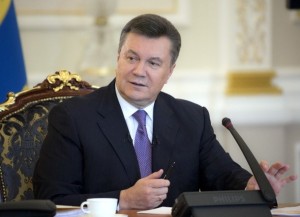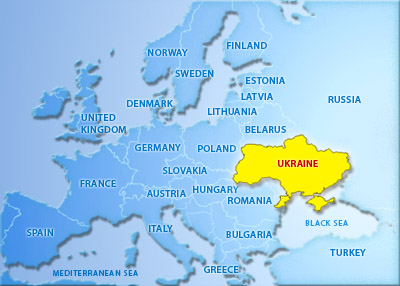redo Jump to...
print Print...

Ukraine’s President Viktor Yanukovych
(by David Blair, London’s Daily Telegraph) KIEV – Ukraine’s president dismissed the entire government and abandoned nine hated security laws on Tuesday, conceding everything to Kiev’s demonstrators except his own resignation.
As he struggled to end the occupation of his capital by tens of thousands of protesters, President Viktor Yanukovych gave in to a series of their demands, sacrificing his prime minister and every member of the cabinet.
An emergency session of the country’s parliament tried to appease the marchers by repealing nine draconian security laws by 361 votes to two. It was the passage of these measures, banning almost all forms of public protest, which had galvanized the protests against Mr. Yanukovych.
Yet only 12 days after approving the laws, MPs scrapped them without debate. All were abandoned during a single vote that took less than a minute.
“Everything the opposition wanted is in this package,” said Volodymyr Rybak, the speaker. As recently as Friday, the president had promised only to “amend” and “review” the laws.
A few streets away, calm descended on the barricades around Independence Square as parliament bowed to the protesters. The main rampart on Grushevskogo street, previously the scene of round-the-clock confrontations between masked demonstrators and serried [solid] ranks of police, was unusually quiet. The taunts died away, a police water cannon stood unused and both sides appeared to respect an undeclared truce.
 After the parliamentary vote, Mr. Yanukovych proceeded to jettison [dump] his allies. Mykola Azarov announced his resignation as prime minister “for the sake of the peaceful settlement of the conflict.”
After the parliamentary vote, Mr. Yanukovych proceeded to jettison [dump] his allies. Mykola Azarov announced his resignation as prime minister “for the sake of the peaceful settlement of the conflict.”
Mr. Yanukovych then stated that every other minister had been dismissed. “The president has accepted the resignation of the government as well,” said an official statement.
It was unclear whether the concessions would satisfy the protesters – or whether nothing less than Mr Yanukovych’s own resignation will now end the unrest.
World boxing champion Vitali Klitschko, head of the opposition UDAR (Punch) party, said the mass resignation was “not victory but a step to victory.”
Behind the snow-clad barricades in Independence Square – popularly known as “the Maidan” – there was no mood of jubilation over the president’s retreat. Instead, people promised to stay until he resigned.
“Of course we must continue until the very end,” said Dina Sokolova, a 60-year-old demonstrator. “…I’m here at the protest until Yanukovych goes.” …
Mrs. Sokolova carried a banner reading “Ukraine is ruled by bandits and ex-prisoners,” an allusion to the fact that Mr. Yanukovych served time in jail for theft and assault in his youth.
The demonstrations began on Dec. 1 after the president spurned a long-planned agreement for closer integration with the European Union in favor of accepting a $15 billion loan from Russia.
President Vladimir Putin made clear that Russia would continue to disburse this money regardless of who is in power in Ukraine, adding that the EU should stay out of the nation’s affairs.
“I think that the more intermediaries there are, the more problems there are. At the very least, Russia will never interfere,” he said after attending an EU summit in Brussels. His comments were seen as a pointed reference to Baroness Ashton, the EU’s foreign policy chief, who had previously been cheered by protesters in Kiev and who was due to arrive in the city again late on Tuesday evening.
The opposition is wary of Mr. Yanukovych’s concessions, pointing out that Ukraine’s constitution gives the president supreme executive power, so the prime minister and cabinet count for little. Parliament’s repeal of the security laws will also require his signature. Some fear that he will set conditions, perhaps demanding an end to the protests first.
Posters of Yulia Tymoshenko, the former prime minister who was jailed in 2011 on trumped-up [made up; fake] corruption charges, adorn the stage in Independence Square. Yesterday, her 33-year-old daughter, Eugenia, told the Telegraph that the president’s moves were “not enough for people who want real systemic change.”
She added: “I think the protests will continue. If people have been there for almost two months, they will not leave now.”
Ms. Tymoshenko predicted that the rallies would go on regardless of the views of any mainstream politician. “I don’t think my opinion or the opinion of any of the opposition leaders could really change the mood of the people,” she said.
Reprinted here for educational purposes only. From a Telegraph news report, with excerpts added from the Daily Mail article. May not be reproduced on other websites without permission from the Daily Telegraph.
Questions
NOTE to students: Read the “Background” and watch the video under “Resources” before answering the questions.
1. The first paragraph of a news article should answer the questions who, what, where and when. List the who, what, where and when of this news item. (NOTE: The remainder of a news article provides details on the why and/or how.)
2. What caused the massive ongoing protests that have taken place in Ukraine since December?
3. How did President Yanukovych attempt to appease protesters earlier this week?
4. How are the protesters reacting to the President’s concessions?
5. Why are protesters skeptical about Mr. Yanukovych’s concessions?
Background
The protesters oppose President Viktor Yanukovych‘s policy of strengthening ties with Russia rather than the western EU [European Union].
They began a series of rallies in November calling for his resignation.
The protests, and occupation of the square by activists, were sparked by Mr. Yanukovych’s decision to abandon plans to sign an association agreement with the European Union.
Instead, Ukraine struck a deal with Russia in December. In December crowds protesting Mr. Yanukovych’s presidency were estimated at 200,000.
The opposition has vowed to continue the protests until President Yanukovych agrees to early elections.
Q&A: Stand-off in Ukraine over EU agreement (from a BBC News post on Jan. 28)
- Protests have gripped Ukraine since the government rejected a far-reaching accord with the EU in favor of stronger ties with Russia in November 2013.
- They turned violent on January 19, and deadly on January 22 in the capital, Kiev, where confrontation degenerated into rioting after the government brought in tough new legislation to end mass protests on the main square.
- Opposition leaders and President Viktor Yanukovych then held talks, and on January 28, Prime Minister Mykola Azarov and his cabinet resigned.
- The Ukrainian parliament also voted overwhelmingly to annul the new anti-protest laws that he had just passed.
How bad is the violence?
Two people were shot dead at the site of the Kiev protest camp on Independence Square on January 22, after three nights of rioting. Another was found dead with torture marks in a forest near the capital. On January 25 a fourth protester was said to have died from injuries sustained in earlier violence.
The interior ministry reported on January 28 that one of three policemen stabbed by protesters in the southern city of Kherson had died.
The scenes late on January 19 were some of the worst in nearly two months of demonstrations, with protesters torching several police buses and other vehicles, while police responded with tear gas, rubber bullets and water cannon.
Hundreds of protesters and police officers have been injured in the unrest. Protests have spread to a number of Ukrainian cities, mostly in the west of the country but also in Mr. Yanukovych’s traditional support base in the east.
What caused the protests?
The anti-protest laws certainly raised passion among the protesters. It had prescribed jail terms for anyone blockading public buildings and banned the wearing of masks or helmets at demonstrations.
But the original trigger for the protests was President Yanukovych’s decision not to sign a major partnership deal with the EU, despite years of negotiations aimed at integrating Ukraine with the 28-nation bloc.
Thousands of pro-EU Ukrainians poured on to the streets of the capital, urging President Yanukovych to cancel his U-turn and go ahead with the EU deal after all. He refused, and the protests continued.
When riot police first took action on November 30, the images of them breaking up a student protest and leaving dozens of people injured only fueled anger with the president and boosted the crowds in Independence Square.
The authorities sought to defuse the anger through measures such as the suspension of the mayor of Kiev and the release of detainees.
On December 17, Russia and Ukraine announced a major deal under which Russia would buy $15 billion worth of Ukrainian government bonds and slash the price of Russian gas sold to Ukraine.
The deal appeared to take the wind out of the sails of the protest movement but when a pro-opposition journalist, Tetyana Chornovol, was beaten up by unknown assailants on December 25, there was an outcry.
How has the West reacted?
The US embassy in Kiev revoked the visas of “several Ukrainians who were linked to the violence” after the deaths on January 22. …
Both the EU and US condemned the new anti-protest laws, saying they were incompatible with Ukrainians’ democratic aspirations.
They also warned Ukraine not to introduce a state of emergency. Amid the concerns, top EU diplomat Catherine Ashton brought forward her trip to Ukraine to January 28.
Is Russia pulling the strings in Kiev?
To many observers, the deal struck between Russia and Ukraine on December 17 points to a carrot-and-stick approach by the Kremlin.
The 2004 Orange Revolution led to Mr. Yanukovych’s removal from power after his election was judged to have been fraudulent. Russia backed him then – and backs him now.
For centuries Ukraine was controlled by Moscow and many Russians see Ukraine as vital to Russian interests.
After the riots erupted on January 19, Russian Foreign Minister Sergei Lavrov warned the protests were “getting out of control,” and accused European politicians of stirring up the trouble.
What happens next?
Mr. Yanukovych, who was democratically elected in 2010, still has a strong support base in eastern and southern Ukraine, and there have been street demonstrations by his supporters.
On January 25 the president offered the opposition a number of senior positions in the government – including prime minister – but the deal was rejected. The opposition said that while talks would continue, key demands, including fresh elections, must be met before the protests could cease.
On January 28, President Yanukovych accepted the resignation of the prime minister and his cabinet, and parliament repealed the anti-protest laws.
However, it remains unclear how this will affect the protest movement.
Daily “Answers” emails are provided for Daily News Articles, Tuesday’s World Events and Friday’s News Quiz.



